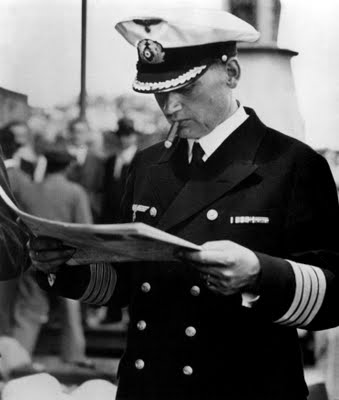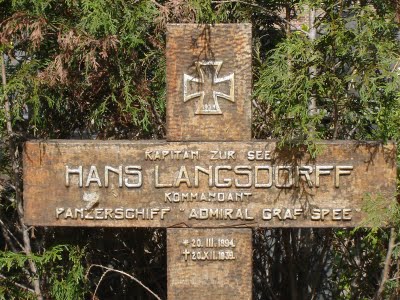(20 March 1894 – 19 December 1939)

Kapitän Hans Langsdorff takes a smoke as he reads the morning newspaper on the morning before his death.
For those of you who haven’t seen Battle of the River Plate as every schoolboy should, he is the infamous captain of Admiral Graf Spee, pocket battleship, pride of the navy of the Third Reich and scourge of British merchant shipping in the opening months of the Second World War.
In anticipation of a British declaration of war, Langsdorff was sent with the Graf Spee to hide in the open ocean off the coast of Brazil in late August 1939. The German authorities wanted to ascertain how serious British involvement in the war was going to be before starting operations, but on the 20th of September, just two weeks into the war, Langsdorff was let loose.
The Graf Spee was renowned for being “faster than anything bigger, and bigger than anything faster”. Langsdorff zig-zagged across the Atlantic, sinking Allied merchant shipping all over the place, giving the impression that there was a large fleet of ships dedicated to this task.
Captain Langsdorff, however, was not a monster. Despite sinking over 50,000 tonnes of Allied shipping, in nine separate raids, Langsdorff ensured that not a single life – German or Allied – was lost in the process.
When he encountered Allied shipping, he would send a message to the unfortunate ship, telling them not to attempt to send out information by radio, with the threat of immediate sinking. Even when Allied captains defied this command and sent out messages, Langsdorff did not fire upon the ships, instead evacuating all souls on board to his supply ship, the Altmark, before scuttling the merchant ship peacefully. When faced with meeting the captains who had disobeyed his instructions, he personally commended them for making the right choice, despite the (perceived) risk to their own life.
Unfortunately for Langsdorff, he found all this gentlemanly warfare against merchant shipping to be somewhat lacklustre, and sought the martial validation of a strike against Allied battleships.
This hubristic, human urge led Langsdorff into what would be his final engagement – the Battle of the River Plate. Whilst details of the battle can be found here, the most interesting part came directly after the battle.
Unseaworthy through the damage sustained in the fight against three Allied cruisers, the Graf Spee limped into Montevideo harbour in the neutral country of Uruguay.
Due to various political game-playing by both British and German diplomats, theGraf Spee was able to be made just about seaworthy in Montevideo, but not able to restock her ammunition. This left Langsdorff with a severely depleted magazine – about enough shells to last for around 20 minutes bombardment – and what he was lead to believe was a significant Allied presence in the international waters outside the estuary of the Plate. There was thus little chance that he could fight his way out of the Plate, let alone make it back to Germany.
Langsdorff tried to negotiate alternative solutions to the problem he faced, but was ultimately forced to sail from Montevideo into international waters, towards the Allied fleet.
He therefore set sail. After a short while, whilst still in Uruguayan waters (and thus safe) he transferred almost all of his crew to German freight ships, and sailed out into the estuary of the Plate. All of a sudden, a loud boom was heard, and the Graf Spee burnt and slipped under the water. Langsdorff had scuttled her, and escaped with his officers aboard a small craft. He had avoided a battle to prevent senseless loss of life, and thus saving the lives of the 900 men under his command. This was a decision which reportedly infuriated Adolf Hitler, who, it appears was somewhat of a fan of vainglorious and senseless deaths.
Langsdorff had wanted to go down with his ship, but his fellow officers convinced him that his negotiating skills would be required to ensure that his crew received amnesty in Montevideo. After a couple of days, when Langsdorff had ensured that his crew were safe, he retired to his room, wrote letters to his wife and children, along with a suicide note, lay on the Imperial (not Nazi) ensign of his ship, and shot himself, symbolically going down with the vessel. He did not want to be accused of cowardice in refusing to face the enemy, and so had ended his own life, entwining his fate with that of his ship. He believed that “[f]or a captain with a sense of honor, it goes without saying that his personal fate cannot be separated from that of his ship.”
Whilst, with historical perspective, we modern gents do not agree with the ideals, politics or actions of the nation for which Langsdorff fought, we can, I think, agree that he himself was a gentleman of the highest calibre.
It is evident that the British Naval officers of the time also agreed with this statement, for all those officers present in Montevideo at the time attended his funeral, and he was posthumously honoured by both sides in the battle for his gentlemanly conduct in battle.

One thought on “Kapitän zur See Hans Wilhelm Langsdorff (Iron Cross First Class, Iron Cross Second Class, Hanseatenkreuz)”
Comments are closed.